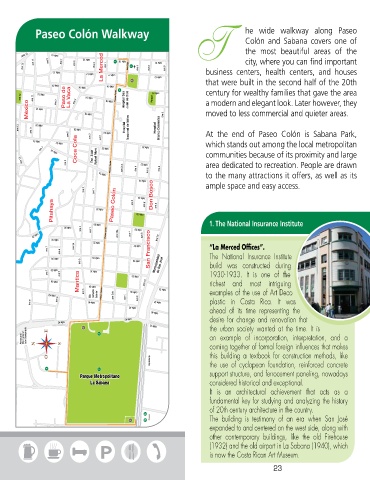Page 212 - Visitor Guides
P. 212
T Colón and Sabana covers one of
Paseo Colón Walkway he wide walkway along Paseo
the most beautiful areas of the
city, where you can find important
business centers, health centers, and houses
that were built in the second half of the 20th
century for wealthy families that gave the area
a modern and elegant look. Later however, they
moved to less commercial and quieter areas.
At the end of Paseo Colón is Sabana Park,
which stands out among the local metropolitan
communities because of its proximity and large
area dedicated to recreation. People are drawn
to the many attractions it offers, as well as its
ample space and easy access.
1. The National Insurance Institute
“La Merced Offices”.
The National Insurance Institute
build was constructed during
1930-1933. It is one of the
richest and most intriguing
examples of the use of Art Deco
plastic in Costa Rica. It was
ahead of its time representing the
desire for change and renovation that
the urban society wanted at the time. It is
an example of incorporation, interpretation, and a
coming together of formal foreign influences that makes
this building a textbook for construction methods, like
the use of cyclopean foundation, reinforced concrete
support structure, and ferrocement paneling, nowadays
considered historical and exceptional.
It is an architectural achievement that acts as a
fundamental key for studying and analyzing the history
of 20th century architecture in the country.
The building is testimony of an era when San José
expanded to and centered on the west side, along with
other contemporary buildings, like the old Firehouse
(1932) and the old airport in La Sabana (1940), which
is now the Costa Rican Art Museum.
ÓÓ

